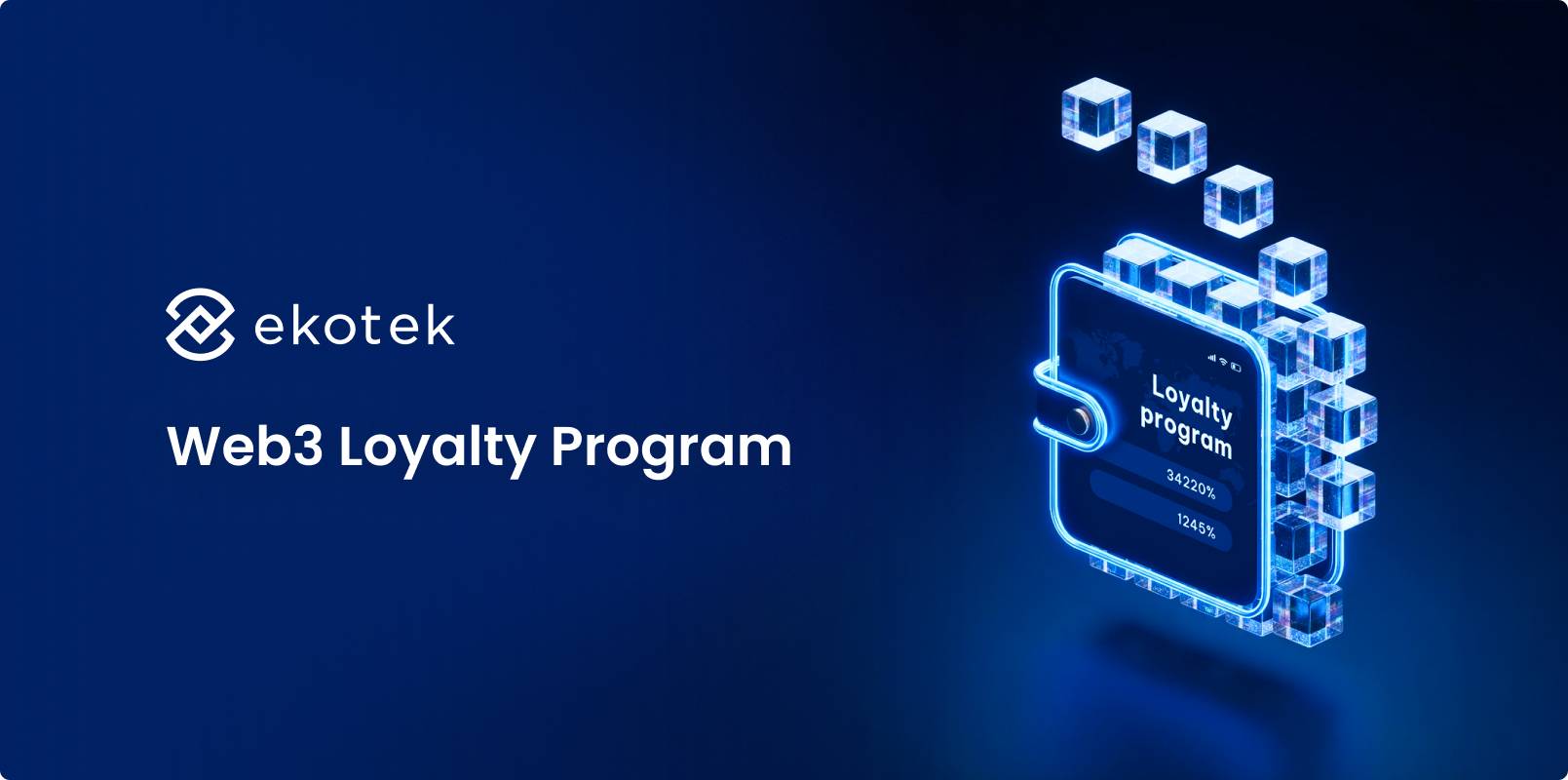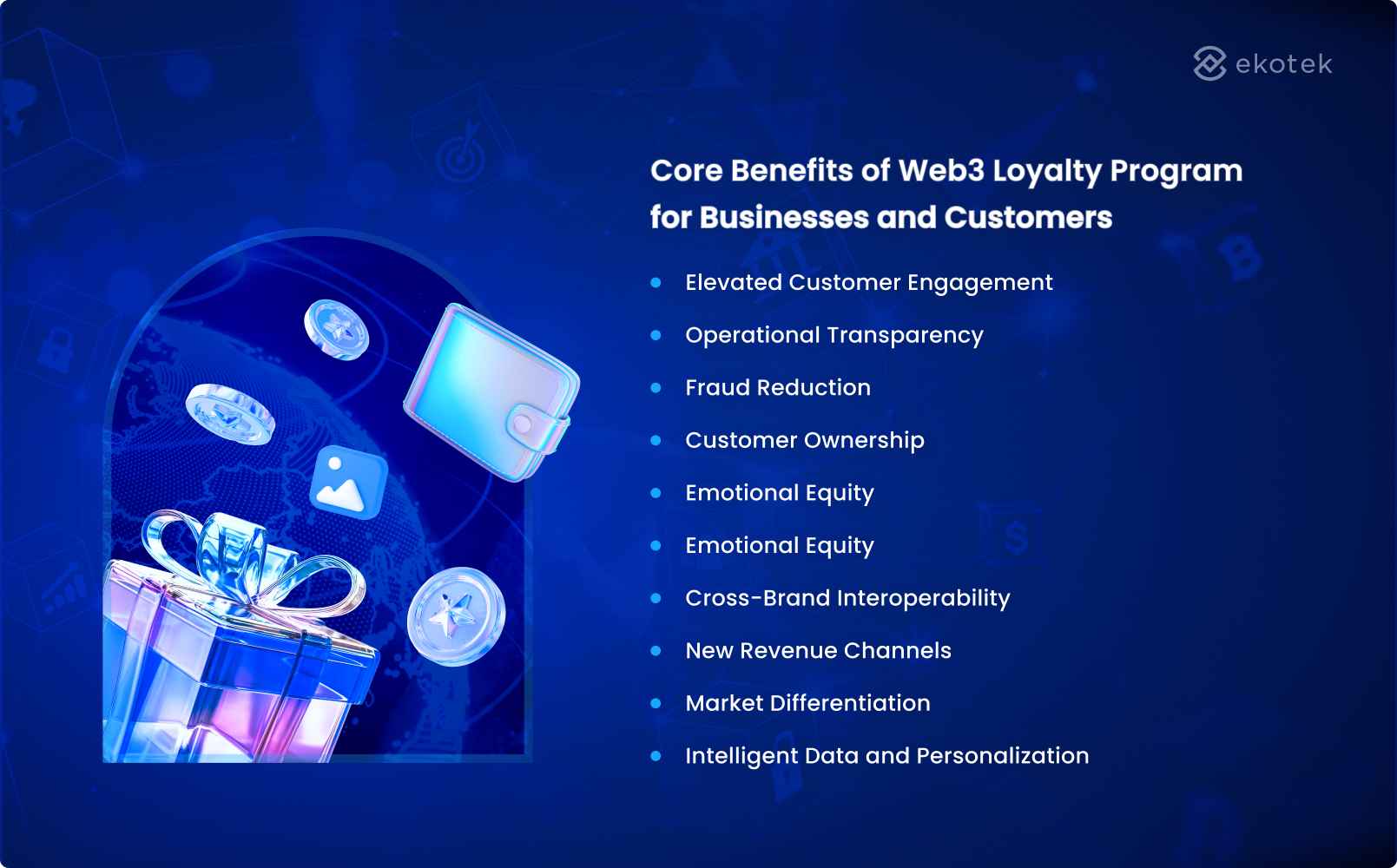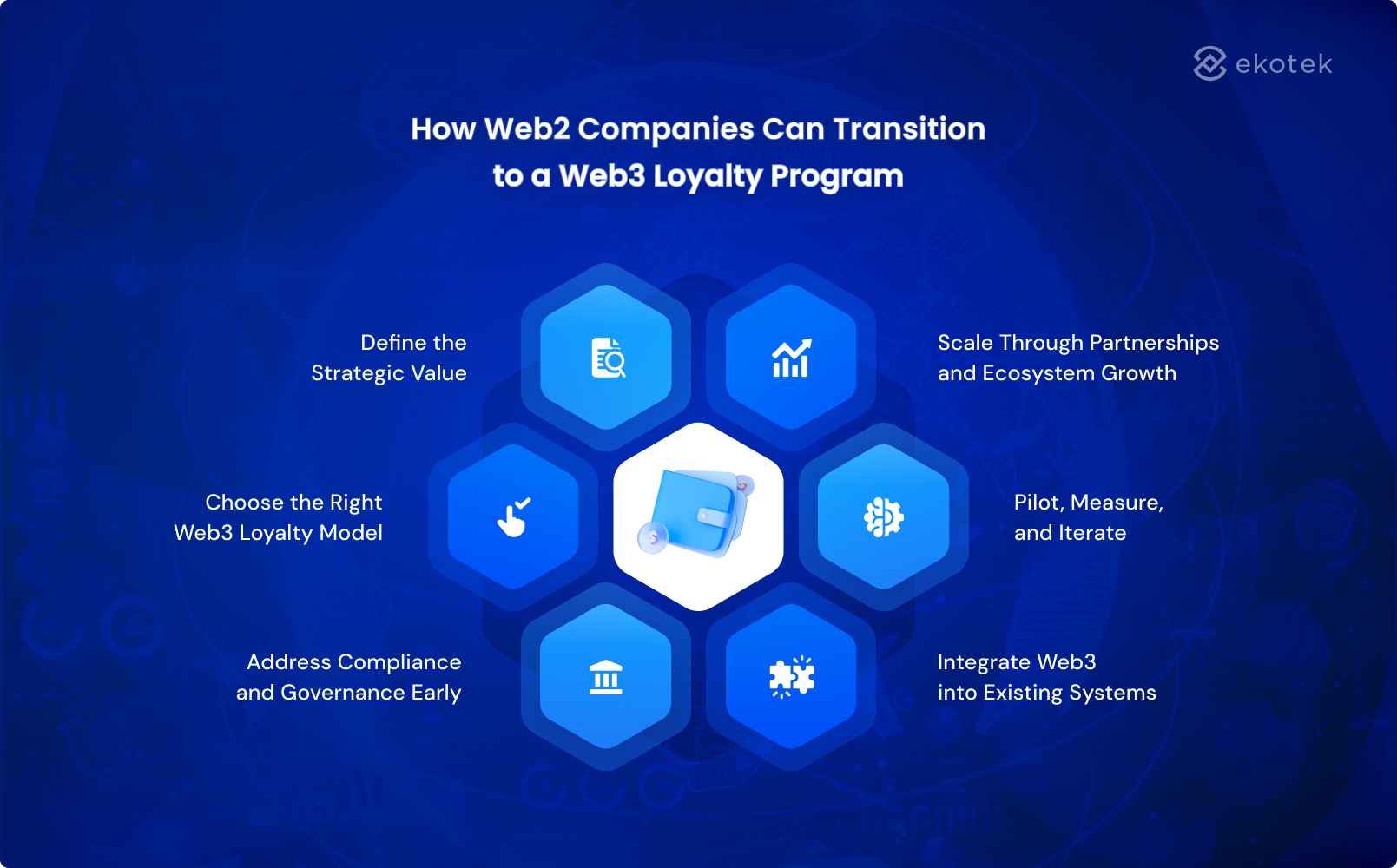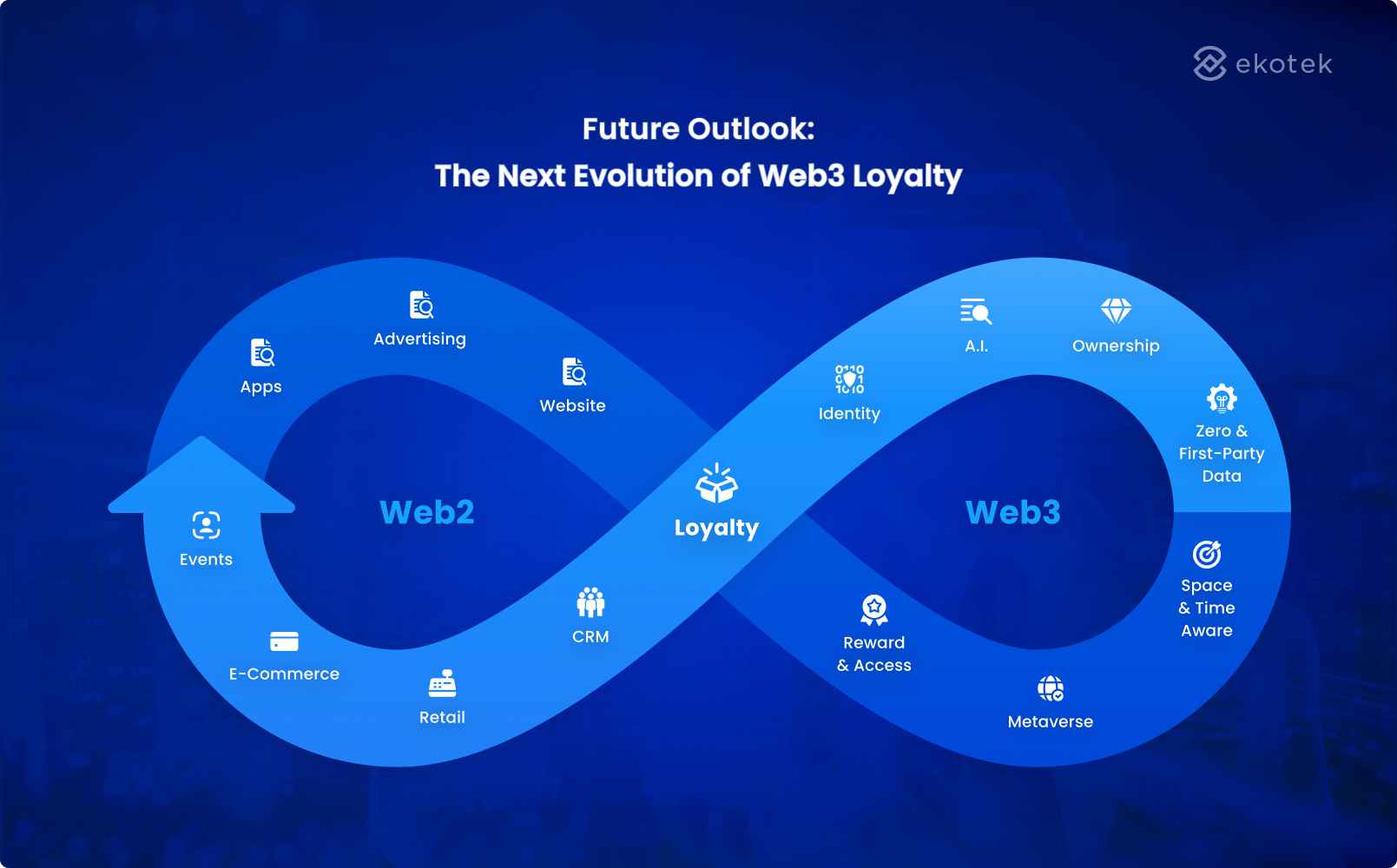
- 1
- 2
- 3
- 4
- 5
- 6
- 7
- 8
- 9
Introduction
Traditional loyalty programs are losing their spark, customers engage less, and brands struggle to stand out. As competition grows and digital behavior evolves, many companies are now exploring how a Web3 loyalty program can rebuild trust, deepen engagement, and create lasting customer value.
Built on blockchain, NFTs, and tokenization, this new model moves beyond points and discounts to deliver transparency, ownership, and community-driven loyalty. In this guide, we’ll explore how forward-thinking businesses are turning loyalty into a strategic advantage in the Web3 era.
Limitations of Traditional Loyalty Systems
Low Engagement and Redemption Rates
Industry averages show a stark reality: only 20% of traditional loyalty program members actively redeem rewards (KPMG, 2024). This “engagement gap” results in millions of dollars in unclaimed value, eroded brand affinity, and diminished program ROI. Customers have become numb to points and generic offers, leading to loyalty program fatigue.
- Programs often fail to adapt offers in real-time, resulting in irrelevant rewards and waning enthusiasm.
- Executive risk: Underperforming programs can drain budgets while providing little measurable impact on loyalty or lifetime value.
Siloed Data Limiting Insights and Flexibility
Traditional loyalty systems frequently operate in isolation, with customer data locked in proprietary silos. This fragmentation limits cross-channel insights and prevents the integration of new customer engagement technology or data analytics tools.
- Brands miss out on holistic customer understanding, making it challenging to tailor experiences or anticipate churn.
- Siloed systems also slow the adoption of advanced technology such as AI, impeding innovation and competitive agility.
Fraud Risk and Operational Inefficiency
Conventional point systems are susceptible to double-spending, fraudulent redemptions, and manipulation by bots, a risk magnified in sectors such as retail and e-commerce.
- Manual processes and a lack of transparency increase auditing costs and slow reconciliation.
- Fraud not only damages the bottom line but erodes customer trust, a board-level crisis when made public.
What Makes Web3 Loyalty Program Different: Blockchain Transparency, Tokenized Rewards, and Digital Ownership
Web3 loyalty programs aren’t just an upgrade of traditional systems, they represent a complete redesign of how value, trust, and engagement are created between brands and customers. Three key innovations, blockchain, tokenization, and digital ownership, are driving this shift.
Blockchain: Transparency and Trust in Web3 loyalty program
Blockchain forms the backbone of Web3 loyalty programs by recording every earning, redemption, or transfer on a secure, tamper-proof ledger.
-
Builds trust and credibility through transparent, verifiable transactions.
-
Eliminates fraud and simplifies auditing, reducing operational complexity.
-
Enhances efficiency and accountability, making reconciliation faster and more accurate.
Customers can clearly see what they own and how rewards are earned, while enterprises gain a reliable foundation for scalable loyalty management.
👉 Unlock the potential of blockchain for your business
Tokenized Rewards: Flexibility and Value Creation
Tokenization transforms static loyalty points into dynamic, digital assets with real value.
-
Rewards become interoperable, usable across multiple brands or ecosystems.
-
Tokens can be exchanged, traded, or upgraded, keeping customers continuously engaged.
-
Businesses can create new revenue models, from cross-brand partnerships to gamified campaigns.
This flexibility turns loyalty into an evolving experience rather than a one-time transaction.
👉 Understand the rise of RWA tokens
Digital Ownership: Empowering the Customer
Digital ownership, enabled by NFTs or blockchain-based tokens, gives customers true control over their rewards.
-
Customers become active participants, not passive members.
-
Owned rewards can be collected, displayed, or traded, increasing emotional connection.
-
Brands benefit from community-driven growth and more authentic customer advocacy.
Ownership transforms loyalty into a relationship built on empowerment and shared value.
Core Benefits of Web3 Loyalty Program for Businesses and Customers
 Elevated Customer Engagement and Lifetime Value
Elevated Customer Engagement and Lifetime Value
Traditional loyalty systems often plateau due to repetitive, transactional incentives. Web3 introduces experiential participation, customers earn, collect, or trade digital assets that represent real, emotional value. The result is sustained engagement and higher customer lifetime value (CLV).
From a business standpoint, this model fosters community-based retention, reducing churn and building a layer of organic advocacy that is difficult for competitors to replicate.
Fraud Reduction and Operational Transparency with Web3 loyalty program
Blockchain’s immutable ledger eliminates one of the largest hidden costs in legacy loyalty systems: fraud and reconciliation inefficiency. Every loyalty event, issuance, redemption, or transfer, is verifiable in real time.
For CFOs and compliance officers, this translates into reduced auditing costs, faster reconciliation cycles, and a data trail that supports ISO and GDPR-compliant transparency. It also enhances investor confidence by demonstrating accountable, traceable engagement metrics.
Customer Ownership and Emotional Equity
In Web3 loyalty, customers truly own their rewards. NFTs or tokenized assets are stored in personal digital wallets, shifting the relationship from “brand-owned data” to “customer-owned participation.”
This shift drives emotional equity, customers become stakeholders in the brand ecosystem rather than passive consumers. For CMOs and brand strategists, this ownership translates into higher advocacy, willingness to co-create, and a more authentic connection to brand identity.
Cross-Brand Interoperability and Ecosystem Synergy in Web3 loyalty program
Unlike closed, proprietary point systems, Web3 loyalty operates across networks. Tokenized rewards can be recognized by partner brands or integrated into broader ecosystems, creating multiplier effects for engagement.
For executives overseeing alliances or ecosystem strategy, this interoperability opens entirely new business models: co-branded campaigns, joint experiences, and shared customer data insights, all underpinned by secure, transparent blockchain frameworks.
New Revenue Channels and Market Differentiation
Web3 transforms loyalty from a cost to a profit driver. Tokenized assets can generate direct revenue through secondary market trading, limited-edition digital releases, or royalty mechanisms.
This approach repositions loyalty programs as strategic business units capable of producing measurable ROI. For enterprise leaders, it also creates differentiation, positioning the brand at the forefront of digital innovation while reinforcing long-term value creation.
Intelligent Data and Personalization at Scale
Web3 infrastructure integrates seamlessly with AI and data analytics, providing a holistic view of customer behavior. Unlike siloed legacy databases, blockchain-based systems ensure transparent, permissioned access to customer data.
This enables hyper-personalized reward strategies, predictive modeling, and more efficient resource allocation. For decision-makers, it means turning loyalty data into actionable intelligence, improving both customer experience and business performance.
Real-World Use Cases of Web3 Loyalty Programs
Starbucks Odyssey: Reinventing Food and Beverage Loyalty
Starbucks wanted to evolve beyond traditional points by creating deeper, more emotional customer engagement. The goal was to turn loyalty into an experience, not just a transaction.
Approach: Built on Polygon, Starbucks Odyssey allows customers to complete brand “journeys” and earn NFT “Stamps” that unlock exclusive rewards or access. The program removes crypto complexity, allowing users to join with existing Starbucks accounts.
Results:
-
The first NFT collection sold out in under 20 minutes.
-
Secondary trading reinforced the real-world value of rewards.
-
Key learning: mainstream adoption requires a simple, frictionless experience.
Hugo Boss XP: Fashion Loyalty for the Mainstream Consumer
Hugo Boss aimed to modernize its loyalty program with blockchain transparency and digital experiences, appealing to younger, tech-savvy audiences.
Approach: Hugo Boss XP combines traditional tiers and rewards with tokenized assets, enabling members to unlock exclusive events, collaborations, and benefits across channels.
Results:
-
Double-digit growth in new sign-ups and app engagement after launch.
-
Expanded from the UK to major EU markets within months.
-
Strengthened omnichannel loyalty and data insight capabilities.
Ekotek delivered a Web3 loyalty program for a global F&B company
When a global beverage brand wanted to move beyond discounts and static point systems, it partnered with Ekotek to explore how Web3 could unlock deeper, more authentic customer engagement.
In just 3months, Ekotek built a custom NFT marketplace and blockchain-based loyalty solution that merged digital collectibles with real-world experiences, all without requiring crypto wallets or technical knowledge from users.
The result: a new engagement channel that bridged physical products, digital ownership, and brand storytelling.
The project proved that even in traditional industries like F&B, Web3 loyalty can be simple, scalable, and commercially viable when designed with accessibility in mind.
👉 See how Ekotek built an NFT marketplace for a F&B company
Web3 Rewards Platform For Traditional Businesses
How can a traditional business launch a blockchain-based loyalty program without needing an in-house Web3 team?
Ekotek answered that challenge by developing a modular Web3 rewards platform, a ready-to-integrate system that lets enterprises issue on-chain rewards, tokens, or NFTs seamlessly within their existing infrastructure.
Built for scalability and accessibility, it bridges the gap between legacy systems and the next generation of customer engagement.
👉 Explore how this Web3 rewards platform works in practice
How Web2 Companies Can Transition to a Web3 Loyalty Program
 Moving from a traditional loyalty system to a Web3-based model isn’t just about technology, it’s about rethinking ownership, engagement, and interoperability. Below is a six-step framework for Web2 enterprises to make that transition efficiently and strategically.
Moving from a traditional loyalty system to a Web3-based model isn’t just about technology, it’s about rethinking ownership, engagement, and interoperability. Below is a six-step framework for Web2 enterprises to make that transition efficiently and strategically.
Define the Strategic Value
Start by identifying why Web3 matters for your business. Is it deeper customer engagement through digital ownership, or the ability to co-create loyalty ecosystems with partners?
Focus on business outcomes, such as lifetime value uplift, cross-brand engagement, or lower reward distribution costs, rather than the tech itself.
Once the value proposition is clear, secure internal alignment and sponsorship at the executive level.
Choose the Right Web3 Loyalty Model
Decide on the format that best fits your brand experience:
- Tokenized rewards or NFTs to represent ownership and exclusivity.
- On-chain tiers or badges to verify customer status transparently.
- Partner with shared ecosystems to allow cross-brand earning and redemption.
Keep the model simple at first. Web3 technology should enhance, not replace, the emotional and commercial value your current program already delivers.
Address Compliance and Governance Early
Before building, establish a compliance and governance framework.
- Map how data, token issuance, and user consent will operate within existing privacy and loyalty regulations.
- Define policies for ownership, transferability, and reward expiration.
Integrate Web3 Seamlessly into Existing Systems
This is where most Web2 organizations benefit from specialized Web3 outsourcing vendors, particularly for smart contract development, wallet integration, and blockchain infrastructure setup.
Outsourcing the technical build allows your internal teams to stay focused on strategy, user experience, and customer data integration.
You should aim for seamless UX: one-click wallet creation, gasless transactions, and unified dashboards within your existing app or website.
👉 Ekotek delivers end-to-end blockchain development services that help enterprises innovate securely, scale faster, and stay ahead
Pilot, Measure, and Iterate
- Run a limited pilot with a select user group or region.
- Monitor engagement metrics, token redemption behavior, and customer feedback.
- Use these insights to adjust reward logic, simplify onboarding, and validate ROI before scaling.
- A strong feedback loop at this stage prevents costly redesigns later.
Scale Through Partnerships and Ecosystem Growth
- Once validated, extend your program through co-branded campaigns and cross-brand rewards.
- Interoperability is Web3’s greatest advantage, let customers earn and redeem value across partner ecosystems.
- Maintain flexibility to evolve your token model, support multiple chains, and integrate future loyalty features as the market matures.
Future Outlook: The Next Evolution of Web3 Loyalty
 Interconnected Loyalty Networks
Interconnected Loyalty Networks
The future of loyalty will be built on interoperability. Instead of each brand running a closed program, we’ll see alliances where customers can earn and redeem value across multiple ecosystems.
- For consumers, it feels effortless
- For brands, it opens new co-marketing and retention possibilities without extra acquisition cost.
From Rewards to Ownership
Loyalty will move beyond collecting points to owning digital assets that represent real value, from membership passes to co-created experiences. Customers won’t just participate; they’ll become part of the brand’s extended network, holding tokens or NFTs that signify both belonging and status. This ownership layer makes engagement emotional, not just transactional.
In a survey of young users, 68% of respondents aged 18-24 stated they should own the value they create online, rather than just access it. This mindset shift makes tokenized membership, NFTs, or ownership-based loyalty models much more meaningful to a growing demographic
Smarter, More Human Personalization
The blend of AI and on-chain data will enable a new level of personalization, one that feels more intuitive and respectful. Instead of guessing what users want, brands can recognize verified behaviors on-chain and reward them instantly. Privacy is preserved, trust is strengthened, and experiences feel genuinely one-to-one.
Blending Digital and Physical Worlds
Web3 loyalty will increasingly connect digital actions to real-world outcomes. Imagine an NFT that unlocks a limited product drop, event access, or a premium service upgrade. These “phygital” experiences will bridge loyalty, lifestyle, and identity, creating richer, more memorable brand touchpoints.
Mature Infrastructure and Responsible Growth
As the space evolves, enterprise-grade infrastructure, clearer regulation, and security standards will bring Web3 loyalty into the mainstream. The narrative will shift from experimentation to execution, from pilot projects to global rollouts that integrate directly with CRM and commerce systems.
👉 Curious about what’s next in blockchain? Check out the Best Blockchain Development Trends
Final thoughts
Traditional loyalty models are losing relevance in an era where customers expect transparency, personalization, and true ownership. Web3 loyalty programs address these gaps by turning rewards into digital assets, fostering engagement that’s both emotional and measurable. For enterprises, this shift means transforming loyalty from a cost center into a growth engine powered by blockchain trust and data intelligence. The future belongs to brands that move early, building connected, customer-owned ecosystems where loyalty becomes a shared, enduring value.
As a full-stack Web3 partner, Ekotek supports clients through every stage of transformation: from strategic consulting and architecture design to full development, deployment, and ongoing operation. Our consultants help enterprises reimagine business models for the token economy, while our engineering teams deliver scalable, production-ready blockchain solutions.
Ekotek’s diverse Web3 expertise enables companies to move faster and smarter, whether that means building blockchain infrastructure and smart contracts, creating NFT-based loyalty and digital asset ecosystems, integrating AI-powered Web3 applications, launching DeFi or digital finance platforms, or enabling enterprise-grade adoption through tokenized loyalty, on-chain identity (KYC), and payment gateways.
For traditional businesses exploring Web3, Ekotek bridges innovation with practicality, delivering secure, interoperable, and customer-ready solutions that unlock new value, reduce risk, and accelerate time to market.
FAQ on Web3 Loyalty Program
1. How is a Web3 loyalty program different from a traditional one?
Traditional loyalty programs rely on centralized databases and limited reward systems. Web3 loyalty programs, built on blockchain, enable transparency, interoperability, and digital ownership, allowing customers to truly own and trade their rewards while brands gain richer engagement data and reduced fraud.
2. Do customers need crypto wallets or tokens to join?
Not necessarily. Most modern Web3 loyalty solutions use custodial wallets or seamless sign-ins via email or social accounts. This removes crypto complexity and lets users participate just like in any regular loyalty program, while still benefiting from blockchain transparency.
3. Is it secure and compliant for enterprises?
Yes. Web3 loyalty platforms can be fully compliant with GDPR and financial regulations when designed correctly. Blockchain’s immutable records actually improve auditability and reduce fraud risk. Partnering with experienced Web3 developers ensures enterprise-grade security, custody, and compliance.
4. What’s the ROI for implementing a Web3 loyalty program?
Brands typically see higher engagement and retention because customers value ownership and interoperability. Tokenized rewards create new revenue channels (e.g., resale royalties, cross-brand collaborations) and reduce operational costs tied to fraud and manual reconciliation. The ROI depends on use case design, user adoption, and partner ecosystem scale.
- 1
- 2
- 3
- 4
- 5
- 6
- 7
- 8
- 9